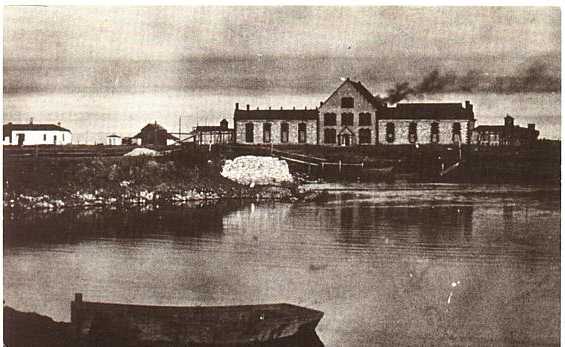
Wyoming Territorial Prison, Laramie, 1872
With territorial status, there came a
need for a facility to house convicted felons. In 1869, the territorial legislature approved the
construction of a prison. The federal government approved funding the following year and two years
later the 42 cell facility opened with Deputy United States Marshal
Nathaniel. K. Boswell as first warden. Until then convicted felons were housed at the
Detroit House of Corrections. Unfortunately, the opening of the new prison
did not solve the problem, since the expense of the
Laramie facility was greater than shipping the inmates out of the Territory. The Prison charged as
much as a $1.00 per day for each prisoner, while after 1878 Nebraska agreed
to house inmates in its State Penitentiary for only forty cents. During the period 1882 to 1887 Illinois agreed to house the prisoners for
free. Thus, during the period from 1882 to 1887 most inmates went off to Joliet. Indeed,
a federal inspection of the Laramie facility in 1884 found only 10 inmates, some of
whom were permitted to go into town on Saturday night.
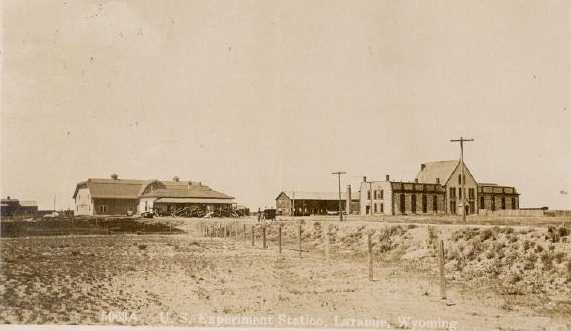
Agricultural Experiment Station, Laramie, approx. 1911
Behind the prison on the right is the broom factory. In addition to brooms, the
inmates constructed furniture, some of which is on display in the Laramie Plains Museum. To the left of the prison is the horse barn. The barn is now
used for a dinner theatre and a museum devoted to the Federal Marshals Service. The small building on the
left, is the warden's residence.
After 1887, the Penitentiary was overcrowded even with the construction of a new wing.
The new wing housed three cells for women inmates and medical facilities. Rules for
inmates were strict. They were required, among other things, to bath in the summertime twice a
week. In the winter they might be required to bathe only once a week.
They laundered and made their own clothes. Among the inmates was
Butch Cassidy Although construction
of a new prison at Rawlins was proposed as early as 1886, it was not until 1903 that a new facility
was opened. It is an old saw (but not true) that in the distribution of the capitol to Cheyenne, the prison to
Rawlins, the lunatic asylum to Evanston, and the University to Laramie, that
Laramie had last choice.
With the opening of the new facility at Rawlins, the old prison was converted to the Agriculture Experiment
Station pictured above, under Bert C. Buffum as director (see Cheyenne III). The area has now
been converted back to a park and museum and includes the United States Marshals' Museum and exhibits as to
early ranch life.
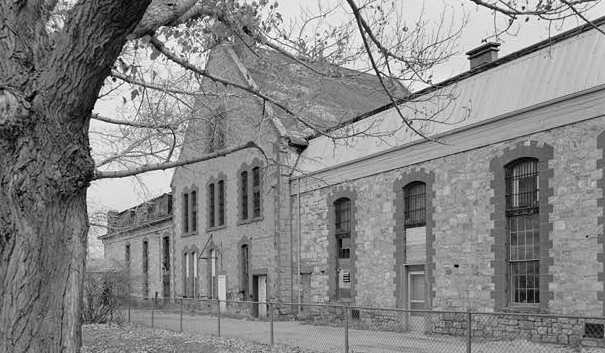
Territorial Prison before conversion to Park and
Museum, photo courtesy Library of Congress
As noted above, the prison has now been converted into a park and museum. Displays include information about the various
periods in the facility's life, including famous prisoners such as Butch Cassidy, the history of the U.S. Marshals' Service, frontier life, and
early ranches. On weekends there are themed activities. For more information visit the park's
Website.
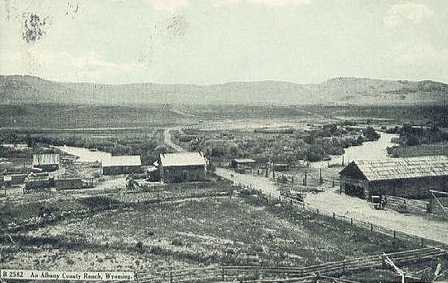
N. K. Boswell Ranch on the Laramie River, Woods Landing, Approx. 1908.
As noted above, Nathaniel K. Boswell, served as the first warden of the Territorial Prison. Boswell
came to Cheyenne in 1867 when it was but a tent city. There for several years he operated
a drug store. He subsequently
served as the first sheriff of Albany County before being appointed as a Deputy United States Marshall, in which
capacity he served as warden. During his career he arrested, among others, Jack McCall. McCall is noted as the one who
shot James Butler "Wild Bill" Hickok in the back as Hickok was playing poker with Carl Mann, Captain William R. Massic, and
Charles Rich in Nuttall and Mann's Saloon Number 10 in
Deadwood City. Hickok held the winning hand, ace of spades, ace of clubs, eight of spades, eight of clubs, and either
a queen or jack of diamonds. Aces and eights are now
commonly known as the "deadman's hand." Boswell also arrested the notorious stage robber George "Big Nose" Parrott.
See Rawlins. One of his deputies was Malcolm Campbell, later Sheriff of
Converse County. Boswell was also noted as a marksman, shooting John Kelly, on the run, at a distance
of 200 yards. Boswell was a Republican and participated in Theodore Roosevelt's famous
55 mile ride from Laramie to Cheyenne. See Cheyenne. The ranch depicted above dates
into the 1870's. The ranch house was constructed by Tom Walden about 1878.
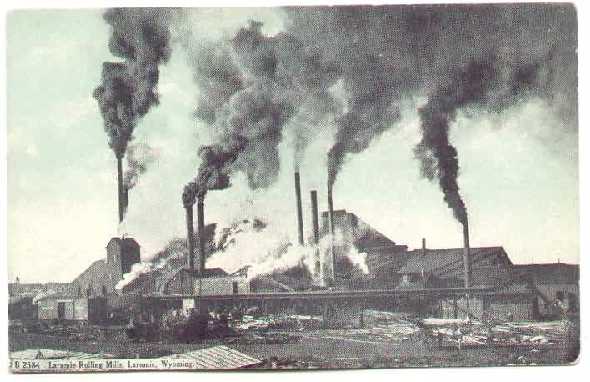
Rolling Mill, Laramie
The Union Pacific Rolling Mill was constructed in 1875 and provided employment for approximately
100 until it burned down in 1910. Conflicting reports were made as to the cause of the fire.
The Boomerang reported that the fire was caused by a spark from a westbound locomotive landing on
a bare part of the roof. The Republican indicated that the fire started in one of the stacks but also noted
that the Superinentent of the mill thought it might have been caused by a locomotive spark. Within 15 minutes of the
discovery of the fire, the roof had collapsed. The first fire plug, the hose company connected to had no water. By the
time a connection was made to another plug, the fire was hopelessly out of control.
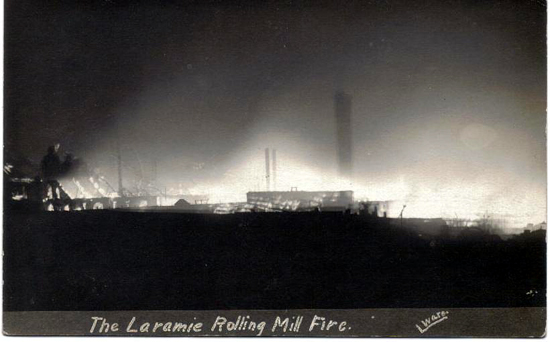
Rolling Mill Fire, November 9, 1910.
The rolling mill rerolled old railroad rails and other metals. The presence of the plant
was believed by the residents of Albany County to be the springboard for
other and further industrial development. As phrased by Professor T. A. Larson in his
History of Wyoming, "it was cherished by Laramie citizens as the acorn which someday might grow into an industrial oak and make
Laramie the 'Pittsburgh of the West'."
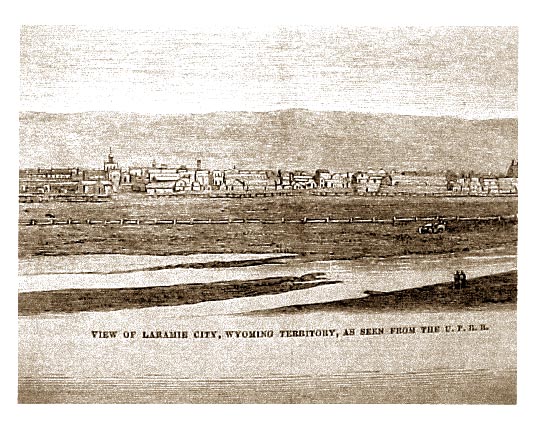
Laramie City, Leslie's Illustrated News, 1877
Soda Lakes are found 19 mikes southwest of Laramie. The soda works were commenced by N. K. Boswell and subsequently sold
to the Union Pacific.
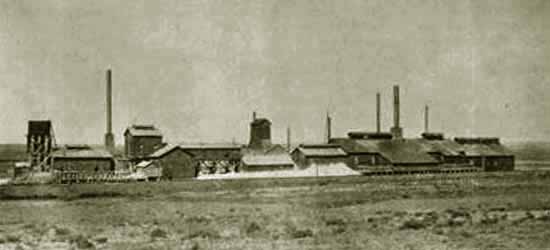
Laramie Soda Works, 1899.
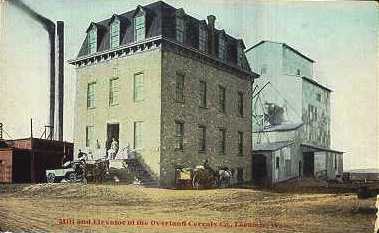
Overland Cereals Company, Laramie
Other seedlings included
a flour mill and a stucco works.
In addition to the Cereals Company and the Acme Cement Plaster Company in the next picture, other industrial
enterprises included a glass factory started by Stephen Wheeler Downey and J. W. Donnellan. Downey served
as Territorial Delegate of Congress and later served on the Board of Trustees and
President of the University. Although the appropriate raw materials for the
glass works were readily available, the plant was unable to compete even in the
Colorado market with eastern glass works. The glass works lasted only two years with
local investors losing an estimated $100,000 in the venture. A cigar plant was also started by
Lewis W. Albershardt. It too did not last and he moved to Nebraska.
Next Page: Laramie Continued, The Trabing Brothers, Augustus Trabing, Charles Trabing, the
Trabing Commercial Company, George W. Trabing.
|